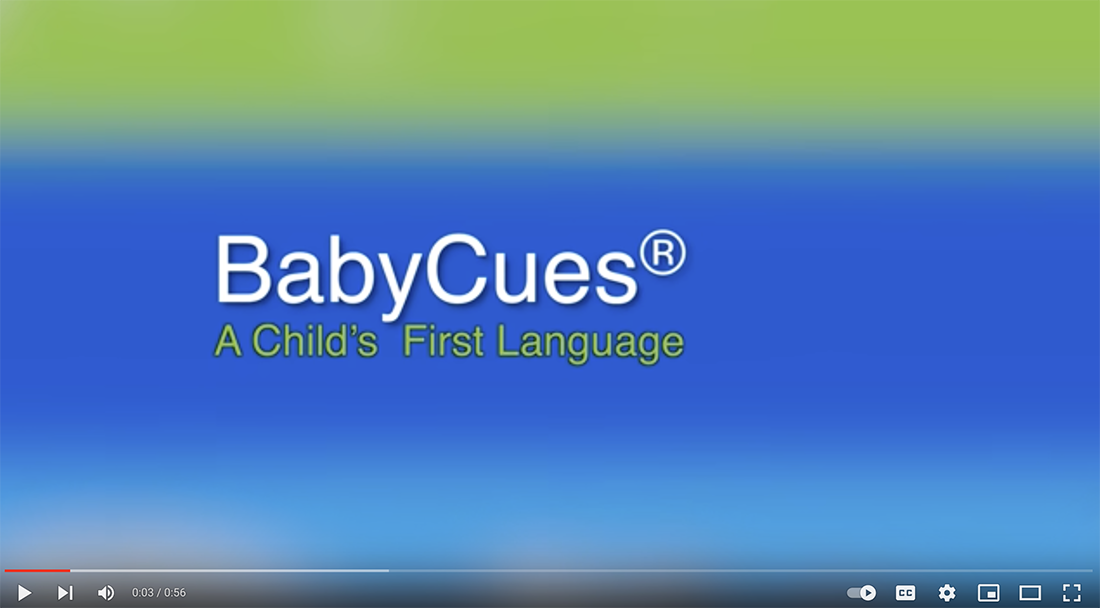
BabyCues® – A Child’s First Language
Learn to read a child’s cues.
Innovative intervention tools that help parents, home visitors and other caregivers be more “tuned in” to their infant and young child’s feelings by learning to understand and respond to their behavioral cues.
Viewing the BabyCues® Video and practicing with the BabyCues® Cards can help parents and other caregivers gain confidence, improve their caregiving skills and ultimately enhance the relationship with the baby or young child in their life.
Learning to read a child’s cues can help parents respond more sensitively by answering questions such as: How can I tell my baby is ready to play and interact? How do I know my child needs a break from an activity? What combination of cues might tell me my baby is hungry?


BabyCues®
A Child’s First Language
Learning BabyCues helps parents, grandparents and other caregivers become more “tuned in” to their baby or young child’s feelings and needs by learning to read and respond to their child’s behavioral cues. By recognizing and responding to a child’s behavioral cues, parents and other caregivers can develop sensitive, responsive relationships with the children in their life.
They can learn when their child is ready to interact and play, when they need to be reassured, or when they need a break from an activity. This in turn builds trust and sets the stage for language and other development. Learning to read a child’s cues can help caregivers respond more sensitively by answering such questions as:
-
How can I tell my baby is ready to play and interact?
-
How do I know my child needs a break from an activity?
-
What combination of cues might tell me my baby is hungry?
-
How can I readily respond to cues to help prevent tantrums?
-
How can I tell my infant is full?
BabyCues® A Child’s First Language Cards is an informative set of 59 cards, including 52 colored photo cards that illustrate and explain behavioral cues commonly seen in infants and young children, plus a fold-out instructional booklet and seven sorting cards. Each card includes a different photo with an explanation on the back explaining the type of cue and what your baby may be telling you.
When parents and caregivers respond to their baby’s cues in positive and sensitive ways, babies learn that they can trust the special adults in their life; this helps them feel safe and secure. When infants send a cue that is appropriately responded to most
of the time, they learn something very important: that they are effective and competent communicators and that their caregiver is predictable and caring. This knowledge becomes a core part of how they see themselves in the world.
The BabyCues Video is a 14 minute video which illustrates baby cues and also shows hunger and satiation cues, and more. The BabyCues Cards and Video were designed for use in the home, in a clinical setting, or as a teaching tool in the classroom. Practicing with the cards can help parents and other caregivers gain confidence, improve their caregiving skills, and ultimately enhance the relationship with the baby or young child in their life.
Here are some ideas to get you started
Discover more ideas and tips! Click on the arrow to see the next class
Exercise 01
BrainstormingPresent parents/caregiver(s) with various scenarios and have the group brainstorm which cues they might observe in each particular situation.
Situation:
I’m teaching my child how to stack blocks.What “Subtle Cues” might I see that tell me my child needs a break or that I need to change something I’m doing?
- Gaze aversion is an example of possible answers
- Frowning
If I don’t recognize and respond to my child’s “Subtle Disengaging” cues, what stronger “Potent Disengaging” cues might my child start sending me?
- Walking away
- Crying
Situation:
I’ve been feeding my 11 month old in his high chair; he’s now fussing and doesn’t want to eat.What “Subtle Disengaging” cues might I see that tell me my child might need a break, that I need to change something I’m doing or maybe he just isn’t hungry?
- Lip compression
- Looking away
If I don’t recognize and respond to my child’s “Subtle Disengaging” cues while feeding him, what stronger “Potent Disengaging” messages might my child send me?
- Maximal lateral gaze aversion
- Pushing food away
- Halt hand
As the facilitator, you can come up with the example situations and then have the parents/caregiver(s) verbally provide answers or pull the cards from the deck that show the appropriate cues.
You could present each situation, and then ask parent(s) to pull some of the “Subtle Disengagement” cues they’ve seen their child display when feeding him/her. Then ask parent(s) to pull some of the “Potent Disengagement” cues which they’ve seen their child display when he or she is full and has had enough food.
Exercise 02
ActingHave learners/caregivers break off into pairs. Give each pair a deck of cards. Have one learner read the name of the cue. Have the other learner display or act out that cue and identify it as a “Subtle” or “Potent” cue.
Have one learner pull two or three cards from the same category such as “Potent Disengaging” or “Subtle Disengaging” or “Disengaging” and “Engaging”. The other adult then acts out this “cluster of cues.”
The pair then changes places and repeats above. This could also be done in front of a classroom, in parent circles, or in small groups.

Exercise 03
Role-PlayingOne adult plays the baby, the other the parent.
The adult role-playing the child displays/acts out cues in relation to a specific situation such as a teaching episode, eating dinner, or confronting a new situation. The purpose of this exercise is to present ways a parent/caregiver can change/modify/repair their behavior in response to the cues the child is sending.
Situation:
Parent is teaching the child to squeak a toy.In response, the adult role-playing the child looks away and frowns. Parent then shows an example of how they could modify their behavior, for example take a short break, give the child more time to explore the object, pick a different toy to squeak, or make other changes in their behavior.
Now, baby (learner) shows “Engagement Cues” in response to the parent’s change in behavior.
For example, parent takes a brief break, chooses a different toy that doesn’t squeak so loudly and then teaches the task again. Now, the child (learner) raises her head and smiles at the parent.
Other situations you could present to parent(s):
Situation
Parent wants to read to child, child is displaying “Subtle Disengagement” cues.
Situation
Parent is feeding baby, wonders how she will know the baby is full. Child is displaying a “clustering of satiation cues.”
Situation
Parent brings baby to Aunt Martha’s to meet a house full of new relatives. With much noise and after passing baby around, baby displays “Subtle Disengagement” cues ending in “Potent Disengagement” cues.
Situation
Toddler arrives at a new daycare center. Upon entering the classroom and meeting all the new teachers and children, child begins to display “Subtle Disengagement” cues.
Situation
Caregiver showing child how to put a puzzle together. Child shows interest by displaying “Subtle and Potent Engaging” cues.
Learner role-playing child acts out the cues and learner role-playing parent responds to the message the child is sending.
Exercise 04
Card SortWhen working one-on-one with a parent or caregiver, try the following exercises.
Sort the deck into what you think might be the most commonly seen cues. Show and explain these cues to the parent. Have parent/caregiver sort cards into the appropriate group, Subtle and Potent Engagement, Subtle and PotentDisengagement.
You could do this together or have parent sort alone. Ask parent if she’s ever seen any of these in her child. Suggest that it might be fun to notice if she starts to see any of these cues in her child. At your next meeting, have her pull out the cue cards that she’s seen her child display since your last meeting.


After a solid understanding of the cues, it is important to explain that you need to look at the total behavior not just one cue in and of itself. Explain clustering of cues.
Explain how recognizing and responding to subtle disengaging cues can help prevent distress and behavior escalating into more potent disengaging behavior such as whining, crying, pushing away, halt hand or walking away.
Explain how caregivers can make slight modifications in their behavior that will re-engage the child and bring them back into the interaction.
Exercise 05
Group SortingDivide class into small groups (4-6 each). Provide each group with a box of cards. On the table put the Disengagingcard and Engaging card. Each group then views cards and sorts into Disengaging and Engaging piles. Give them about 10 minutes to complete task.
Next, have groups pull the Potent and Subtle cards and place on the table. Each group then sorts cards according to whether it is a Potent or Subtle cue.
You can have the group continue this exercise further by sorting cards into Potent and Subtle Disengaging piles and Potent and Subtle Engaging piles.

Exercise 06
Cues My Baby Has Shown Me
Ask parent/caregiver to place My Baby Shows Me These Cues card in front of them.
If they have seen the cue on the card, have them place it under that card. If they have never seen their baby display the cue, have them place the card in a separate pile.
At your next meeting, repeat this exercise to see if the number of cues parent identifies increases.
Questions?
Please give us a call
We look forward to talking with you!
-
Phone
206-543-8528
-
Business hours
Monday – Friday
7:30am – 4pm
-
E-mail
pcrp@uw.edu
-
Mailing Address
Parent-Child Relationship ProgramsUniversity of Washington - Box 357231
Seattle, WA 98195-7231
-
Office Address
Parent-Child Relationship ProgramsUniversity of Washington
Health Sciences Building F-346
Seattle, WA 98195-7231
Prefer exploring on your own?
Check out our FAQ section
for answers to common questions
WE WANT TO CONNECT WITH YOU!
Feel free to fill out our contact form or call us at 206-543-8528
901-773-4045
121 Burton Avenue - Memphis
mail@yourdomain.com
